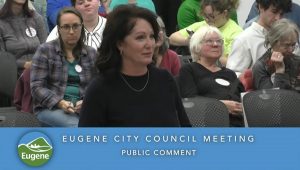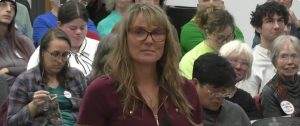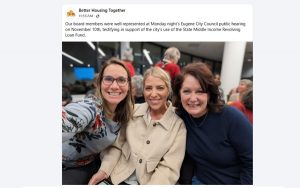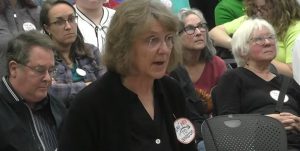Egan Warming Center seeks volunteers to ‘keep people alive one cold night at a time’
6 min read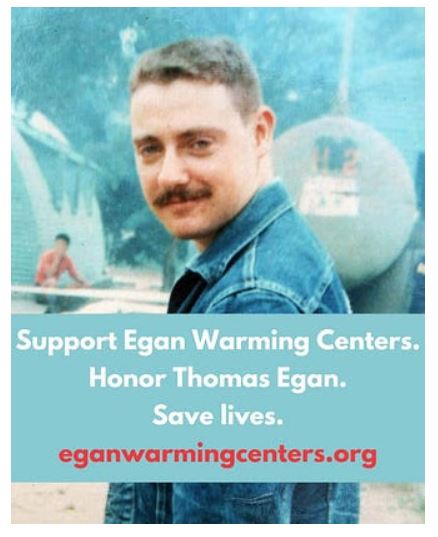
Tim Black: On those dangerously cold nights, when everything else is closed down, that’s when Egan Warming Center is there for anybody who needs shelter on that night. Our goal is to keep people alive one cold night at a time, it’s a very simple mission.
[00:00:14] John Q: Tim Black from the Egan Warming Center made an appeal for volunteers this winter.
[00:00:19] Tim Black: Those who don’t know, Egan Warming Center is named after Lieutenant Thomas Egan. He was found frozen to death at the end of Blair Street in December, 2008, after a long cold stretch, and the county stepped in and asked St. Vincent DePaul to be the organization that sort of had the underlying support for Egan Warming Centers.
[00:00:41] We are our community’s low barrier emergency winter shelter program. Low barrier. That’s really the most important part. What that means is, our goal is to have a warm, safe place for anybody seeking shelter on that night, as long as they behave in a manner that supports the safety of everyone involved. That means they could be drunk, they could be high. Lot of mental illness, a lot of substance abuse. That’s okay. We work really hard to make our guests successful, to remain inside those shelters. And if there’s something going on with another guest or something going on, we’ll take them to one of our other shelters so that they can try that.
Thank you for supporting
local civic journalism
[00:01:23] What do we do? It’s based on the temperature. We monitor four weather websites, and we look at their forecasted low temperatures, and if the average of those four is below 30 degrees, so 29.75 or lower, then we start the train moving down the tracks to open, and we make that final decision 48 hours ahead of time because it takes some time to get all of that going.
[00:01:49] And I know people say all the time, well, you know, 32 is freezing. What if it’s raining and it’s 37 and we get all that. We know we miss a few nights here and there where the forecast was 31 and it ended up being 28. Even if we raised the temperature one degree of that protocol, in many years it would double the number of nights that you can open. And it’s just not sustainable. We can’t make the whole thing crash or we lose those times when we really, really need to have the shelter system going.
[00:02:20] Egan Warming Center is volunteers. It’s volunteers, volunteers, volunteers. It’s a series of warming shelters, which has been mostly churches, Temple Beth Israel, faith-based places, a network over the years. With COVID, we lost most of those sites because they couldn’t safely allow other people inside. And we lost most of our volunteers. Most of our volunteers were in their sixties, seventies, eighties, and they couldn’t safely be inside a congregate shelter. We got that. It was a really tough, and we were really concerned that for the first time, we might have to turn people away. While we dodged a bullet and it actually turned out to be a pretty moderate winter temperature wise, and we were only open nine times, and between the space given to us at the Lane Event Center, the fairgrounds and some of our other sites that were there for us, we made it through without turning anybody away. Based on all of the forecasting we’re hearing for this year, I don’t think we’re going to be that lucky.
[00:03:19] Just a bit of numbers, just to give you an idea. When I’m talking about an Egan season, it’s typically November 15th to March 31st, although it got cold in October the last two years, and we actually opened in October the last two ahead of time. The most in Egan’s history was 25 nights. And in the snowstorm year, 2018- 19, we were open 22 nights. We had about 23,000 volunteer hours that year and it took us about 1100 volunteers total for that year. The next year, 2019- 20 we were open 14 nights. A couple other numbers. We typically about 75% male 25% female. We do have one small youth site, but it’s been two to 3% of the number of guests. And that’s always a real challenge to have services for youth. It’s something that keeps us all up at night, worrying about the youth out on the street.
[00:04:09] It wouldn’t work without the volunteers. In a normal year, it takes some 300 volunteers every single night, we’re open. It’s a huge enterprise. And if anybody’s interested, if you’ve ever wanted to learn more, we always have new volunteer orientations. We actually have a couple more on the calendar coming up. You can go to EganWarmingCenter.com to find out about those. Zoom has been great for orientations. It’s 90 minutes. It’s easy from the comfort of your home.
[00:04:35] Jess Tuerk Roshak: Just one question about volunteering. What would be the hours that a typical volunteer might work?
[00:04:41] Tim Black: You can think about it as maybe four basic shifts the evening when we open maybe five to nine, 10, and then the first kind of late night shifts 10 to maybe midnight or 2:00 AM. There’s a couple overnight shifts, usually midnight to five, five to 10. Some people love the overnight. It’s quiet. It’s peaceful. the evenings are always the most popular. Mornings are actually tough. Often the coldest part of the night or the day is 6:00 AM, 7:00 AM, right when we’re trying to get them up and hustle them back out the door.
[00:05:18] I will take this opportunity to go on a little bit of a soap box about taking care of our unhoused neighbors. Number one, they are our neighbors. There’s some misperceptions out there that the better services a community has, then you’re creating a magnet for people to come from other areas. That’s not the case. They might be from the outlying rural areas, but they’re our friends, they’re our neighbors. They may have lost a job. They may have some mental illness. They may have lost their family supports. We all have people in our families that probably can check off one of those boxes.
[00:05:50] We are just there to try to be as compassionate as we can and treat them like anybody, say hello on the street. Good morning. They have so much trauma in their lives already. And can you imagine being by yourself, surviving all the rest of the year, then suddenly on a freezing night to be inside a huge room with a bunch of strangers, it’s traumatic for them. It’s a lot of anxiety producing. We work really hard to make sure that we are not judging them. They know more about themselves than anybody else does. And to try to maintain an atmosphere that will allow them to successfully stay inside.
[00:06:30] Every moment is an exercise in non-judgment and just closing your mouth more often than opening it and just paying attention and listening and making eye contact and trying to be as peaceful and helpful as you can. And you might have some wonderful stories after working in the shelters of people you’ve talked to, but don’t expect that. Don’t go in there thinking, I’m going to go home feeling great. You may not. That’s not why we’re there. We’re there to just make them welcome inside that shelter for one night. That’s all.
[00:07:05] John Q: To volunteer, visit EganWarmingCenter.com.
